We are pleased to host Professor Jacob Israelachvili, UCSB, for our 2nd annual ChE Distinguished Lectureship. He will present his seminar in 100 Huck Life Science, BERG Auditorium, at 4:00 pm on Wednesday, October 26th, 2016. The title of his presentation is “Dynamic (non-equilibrium, rate, time, and history-dependent) Adhesion and Rupture Forces in Material, Soft Matter and Biological Systems”.
Author: Tonnam Balankura
ChE Seminar – Krista S. Walton, Georgia Institute of Technology
ChE Seminar – Bruce Garrett, PNNL
Professor Bruce C. Garrett, Chief Scientist, Chemical Sciences, Pacific Northwest National Laboratory, will be presenting his seminar titled “Fundamental Research for Energy/Environment Solutions: Team Research at Pacific Northwest National Laboratory” on Thursday, September 22, in 102 Chemistry at 10:50 am.
Featured Group of the Month: Dr. Howard Salis
Meet the Salis Lab. Learn how we use biophysical models and methods to rationally predict and control the behavior of biological organisms.
(Left to Right) Grace Vezeau, Alex Reis, Sean Halper, Daniel Cetnar
Grace Vezeau
Current sensing technologies for diagnostic compounds, like human biomarkers or environmental pollutants, rely upon expensive and non-robust equipment. My research seeks to solve this problem by developing RNA-based biosensors. Certain RNA sequences, called aptamers, fold into specific shapes and bind strongly and specifically to target ligands. We can couple this sensing element to a measurable output, such as the expression of a fluorescent protein, by designing the RNA molecule to change shape upon ligand binding. The RNA molecule acts as a switch, where output is turned on when the ligand is present.
I presented my work on TNT-detecting biosensors at the Fall 2015 SynBERC retreat, and will be presenting a broader overview of RNA-based sensors at the Rustbelt RNA meeting this October.
My favorite (set of) equations are the Lotka-Volterra equations, two differential equations describing the population dynamics of predators and their prey. They are one of the first examples of using mathematics to successfully describe a biological phenomenon – a tradition we are carrying through today.
Alex Reis
Precise control over protein expression is required when engineering biological systems. My work is focused on developing sequence-to-function models of gene expression and regulation to allow programmable system behavior encoded at the DNA sequence level.
One of the most direct ways to encode the desired protein level in bacteria is to modify the ribosome binding site (RBS), a section of the protein’s mRNA that governs the rate at which the ribosome is recruited to initiate translation. The RBS Calculator is a thermodynamic equilibrium model used to predict relative protein level given an mRNA sequence (figure). Our group has steadily improved this model since 2009 (Salis et al., Nature Biotechnology), but we have identified subclasses of mRNA that fold slowly or incorrectly that are still poorly predicted. Inspired by these insights, I am building a non-equilibrium model of translation initiation that accounts for these RNA folding dynamics. To do this, I’ve accelerated an existing kinetic Monte Carlo method of RNA folding (FORTRAN) and will soon be building a Markov model to describe the transitions and interactions between an mRNA and the ribosome during translation initiation (Python).
I presented this work at the last Synberc retreat this past Spring at UC Berkeley. I’ll be giving a talk on this model comparison and analysis at AIChE this November in San Francisco (Bioengineering session).
As a side project, Sean, Phillip Clauer (undergrad), and I have also been working on the rational design of nonrepetitive sgRNAs for use in multiplex CRISPR/Cas9 applications. CRISPR is a powerful tool that now allows us to regulate and edit genes in a precise, targeted manner. One major shortcoming of this system is that you can only do one edit or gene knockdown at a time because you are limited by the expression of only one sgRNA. Our nonrepetitive sgRNAs will allow easy DNA synthesis and stable, robust expression of many sgRNAs. This will enable multiple simultaneous gene edits in genome engineering applications, multiple up- and down- regulations of genes in fundamental expression studies, and more complex logic than currently possible in synthetic genetic circuits.
On my mind a lot is the fluctuation theorem (restated as Crooks Fluctuation theorem) from statistical mechanics. The fluctuation theorem can give insights into the nonequilibrium behavior of biology (proteins, RNA, etc.) at the microscopic level. Stated in a general mathematical form below, as the time or system size increases, the forward time trajectory is exponentially more likely than the reverse, given that it produces entropy. In other words, there is always some nonzero probability that the entropy of an isolated system might spontaneously decrease. The second law of thermodynamics is a statistical one!
Sean Halper
In order to bring a desired biochemical product to market, companies and research groups often need to improve the titers of the pathway expressing their product of interest. However, the design-build-test cycle they use to maximize the productivity of pathways via the tuning of enzyme expression is too time-consuming and costly for pathways of sufficient size. My work with the Pathway Map Calculator uses de-dimensionalized kinetic models to model and predict the relationship between enzyme concentration and final product titer for a variety of pathways, while requiring less pathway variant data for large pathways than other methods.
I have presented my work at the Fall 2015 meeting of Synberc in Boston, MA and will be giving a presentation at AIChE this November in San Francisco.
My favorite equation is the semi-official formulation of Murphy’s Law, where Pm is the probability of a social or mechanical malfunction; Km is Murphy’s constant (1); I, C, and U are the importance, complexity, and urgency associated with a given malfunction of frequency F on a base 10 subjective scale, respectively; and Fm is Murphy’s factor (approximately 0.01).
Daniel Cetnar
The use of natural products in medicine remains immensely important with active research occurring in anticancer, antibacterial, and antimicrobial drug development. Today, nearly 70% of all anti-infective drugs derive from natural products.
Interestingly, thousands of sequenced natural product gene clusters exist whose products have never been produced in appreciable quantities due to challenges in producing them in the native host. From sequence homology analysis, many of these natural products likely have useful properties, but have not been produced and confirmed. Discovering high-throughput methods to re-engineer sequenced gene clusters for efficient production in industrial bacterial strains remains immensely important for future drug development. My work aims to develop models and design rules to streamline gene cluster engineering for incorporation into the Operon Calculator. Currently, my work centers on understanding, quantifying, and modeling the structural basis of mRNA degradation to predict mRNA stability and design robust operons for reliable gene expression.
I presented my initial findings on mRNA degradation at the summer 2016 Synthetic Biology: Engineering, Evolution & Design (SEED) conference in Chicago, IL.
My favorite equation is the Hill equation because of its broad usefulness in describing biomolecular interactions. Many of the fundamental papers in Synthetic Biology make use of the Hill equation to describe genetic circuits and gene regulation.
On behalf of the ChE GSA, we would like to thank students from the Salis lab for putting together this awesome summary.
Faculty Candidate Seminar – Dr. Danielle Reifsnyder Hickey – September 27th
Faculty candidate, Danielle Reifsnyder Hickey, postdoc, in Department of Chemical Engineering & Materials Science, of the University of Minnesota, will be presenting her seminar on Tuesday, September 27th in 102 Chemistry at 10:50 am. The title of her presentation is “Atomic-resolution study of nanostructured materials using analytical transmission electron microscopy”.
ChE Seminar – Dr. Manish Kumar – September 1st
Featured Group of the Month: Dr. Michael Janik
The ChE GSA started a new project in July, in which we will feature one of the research groups in our department monthly. Dr. Savage’s group courteously agreed to be our first group. Their profile can be found on our website. This month, our featured group is Dr. Michael Janik’s group.
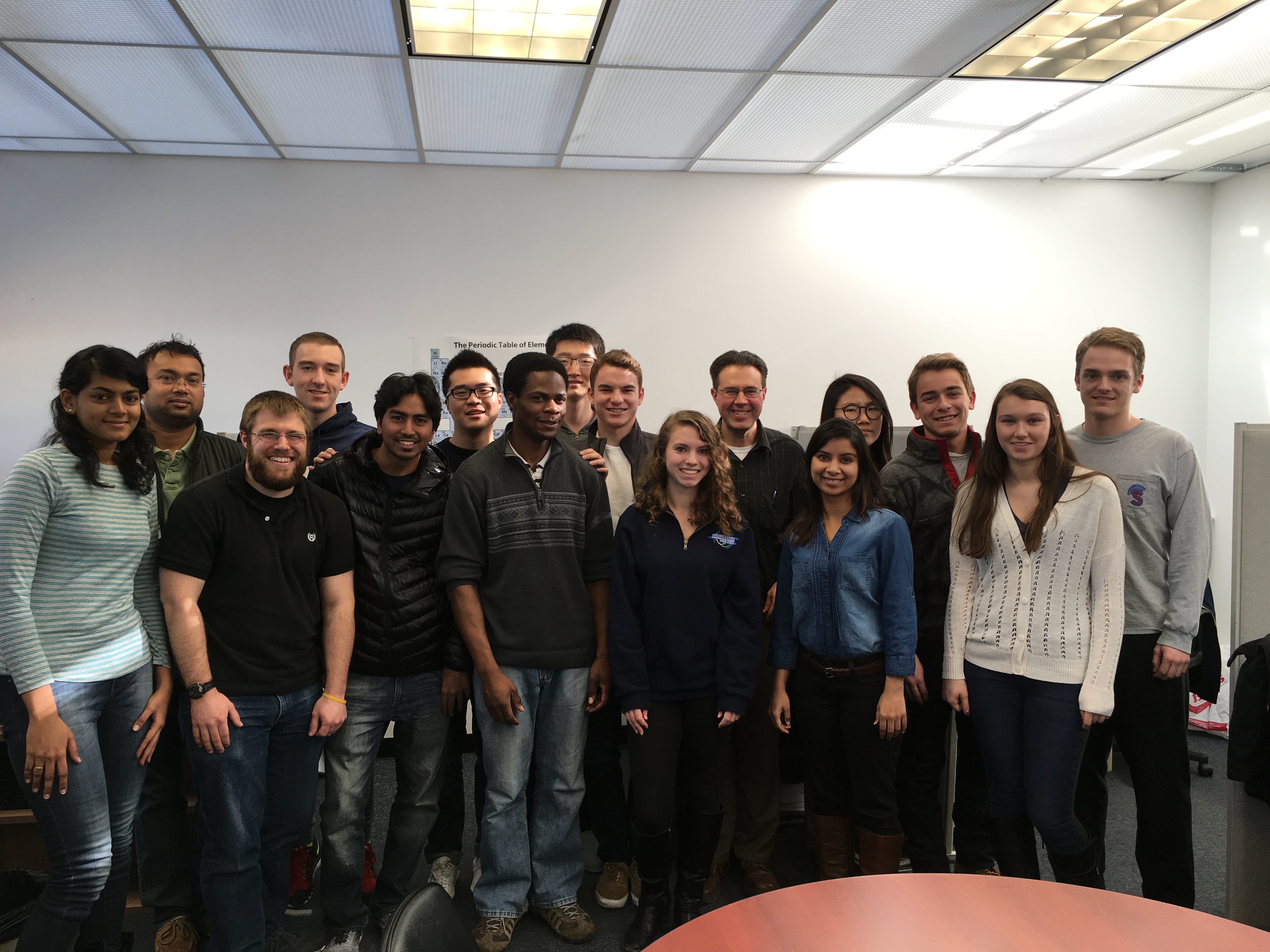
Jiyun Park (Grad Alumni), Robert Nidzyn (UG), James Maximuck (UG)
Megan Ingalls (UG)
We have asked the graduate students within Dr. Janik’s group questions related to their research and here are their responses.
Of course starting off with our ChE-style ice-breaker, what is your favorite equation of all time?
Ian McCrum: I would have to say HΨ=EΨ, the time-independent Schrödinger equation. It appears short and simple but provides a complete description of a time-independent quantum system.
Joel Bombile: Schrodinger equation is like Newton’s Law in classical mechanics. It predicts the future behavior of quantum mechanical systems by describing the time evolution of the associated wavefunctions. A system’s wavefunction gives a complete description its quantum state.
Gaurav Kumar: My favorite equation has to be HΨ=EΨ. It is so simple, yet complex and powerful. I make my supercomputers solve this equation every day.
Hauran He: My favorite equation would be E=mc2 because this equation serves to convert units of mass to units of energy and implies the possibility of converting energy into mass.
Monica Roy: My favorite equation is the Bernoulli equation because it is a simple equation based on a fundamental scientific property of conservation of energy and it has lots of applications.
Let’s now talk about your research. From my understanding, Dr. Janik is very interested in advanced energy conversion technologies and catalysis. What is your project and what is the major problem that your project is trying to solve?
Gaurav Kumar: The overarching theme of my research is the rational design of high-performance catalysts. A major problem in catalysis is the search for highly active and selective catalysts that maximize the yield of the desired product. My goal is to understand intrinsic and extrinsic factors affecting catalysis and use them to guide the design of high-yield stable catalysts, especially for C1 chemistry and biomass conversion.
Monica Roy: My research is focused on trying to understand how methane reforming proceeds on lanthana-doped in ceria. We are interested in understanding dopant distribution, sulfur tolerance and coking resistance of the material so that we can make a good catalyst for methane reforming.
Joel Bombile: I use a mixed quantum and classical approach to model the electronic degrees of freedom of conjugated polymers, taking into account atomic coordinates changes. Motivated by their electronic and mechanical properties combined with low cost and ease of processing, conjugated polymers have found promising application as active elements in organic semiconductor devices. However, the low charge mobility, attributed to disorder in these materials compared to inorganic semiconductors have limited their widespread usage. Transport in conjugated polymers is poorly understood and this hampers the design and sustained development of new high-performance polymer semiconductors. An accurate description of electronic transport in these materials requires an effective account of the interaction between electronic and nuclear degrees of freedom. Coarse-graining is employed to allow access to larger length and time scales.

Hauran He: My research project is about designing a novel catalyst which can hydrogenate benzene or ethylene with high selectivity when they are co-fed into the same reactor. The major problem of this project would be finding a descriptor that can indicate the selectivity of hydrogenation reaction and test a large number of catalysts.
Ian McCrum: I use quantum mechanics to model electrochemical and electrocatalytic reactions that occur in batteries and fuel cells. My main focus is on understanding why electrolyte composition and pH have such a large effect on the rate of the hydrogen oxidation reaction, important for hydrogen fuel cells. If we can more fully understand the mechanism for this reaction, then we can design better, more active catalysts to produce lower cost and higher performing fuel cells.
Have you published your findings?
Gaurav Kumar: I have published two first author papers this year, and another paper is under review. My papers can be found here.
Ian McCrum: My most recent publication involved modeling hydrogen and hydroxide adsorption on stepped platinum electrode surfaces and examining the effect of alkali cations and pH (First principles simulations of cyclic voltammograms on stepped Pt(553) and Pt(533) electrode surfaces).
Joel Bombile: Please find my published work here. The tight binding model I proposed has the ability to replicate the broadening of the absorption spectrum of a dilute polymer by capturing the impact of dihedral fluctuations on the band structure of polythiophene.
Have you presented or will be presenting your work at any conferences in the near future?
Gaurav Kumar: I have presented posters at the North American Catalysis Society biennial meeting in Pittsburgh 2015, the AIChE annual meeting 2015, and the Gordon Research Conference (GRC) in Catalysis 2016. I also gave a talk at the AIChE meeting 2015, and would be presenting my work in AIChE meeting this year in San Fransisco.
Ian McCrum: Presentations I have given at conferences include the following:
– “Alkali cation effects on the hydrogen oxidation reaction in alkaline solutions” PCCS 2014 – Pittsburgh, PA.; AIChE 2014 – Atlanta, GA.
– “Effect of organic and alkali metal cations on the hydrogen oxidation reaction” ECS 2015 – Chicago, IL.
– “Effect of alkali metal cations on the hydrogen oxidation reaction” NACS NAM 2015 – Pittsburgh, PA.
– “Effects of pH and alkali cations on cyclic voltammograms and the HOR/HER” ECS 2016 – San Diego, CA.
– “Understanding how pH and alkali cations affect cyclic voltammograms and the hydrogen oxidation reaction on transition metal surfaces”
ACS 2016 – Philadelphia, PA; AIChE 2016 – San Francisco, CA
Joel Bombile: Our work has been presented at the Fall 2015 MRS meeting in Boston, MA, and at the 2016 Polymer Physics GRC in South Hadley, MA.
Thank you, members of Dr. Janik’s group, for taking the time to talk about their group.
AIChE Annual Meeting 2016 Roommate Matching
The AIChE Annual Meeting in San Francisco is coming up this November. Now is the time where us graduate students find roommates and book hotels.
The ChE GSA is here to help. If you’re looking for a roommate, please fill in the Google doc below and use it to contact a potential roommate!
Featured Group of the Month: Dr. Phil Savage
The ChE GSA is starting a new monthly column that will feature one of the research groups in our department. Our first group is Dr. Phil Savage’s group.
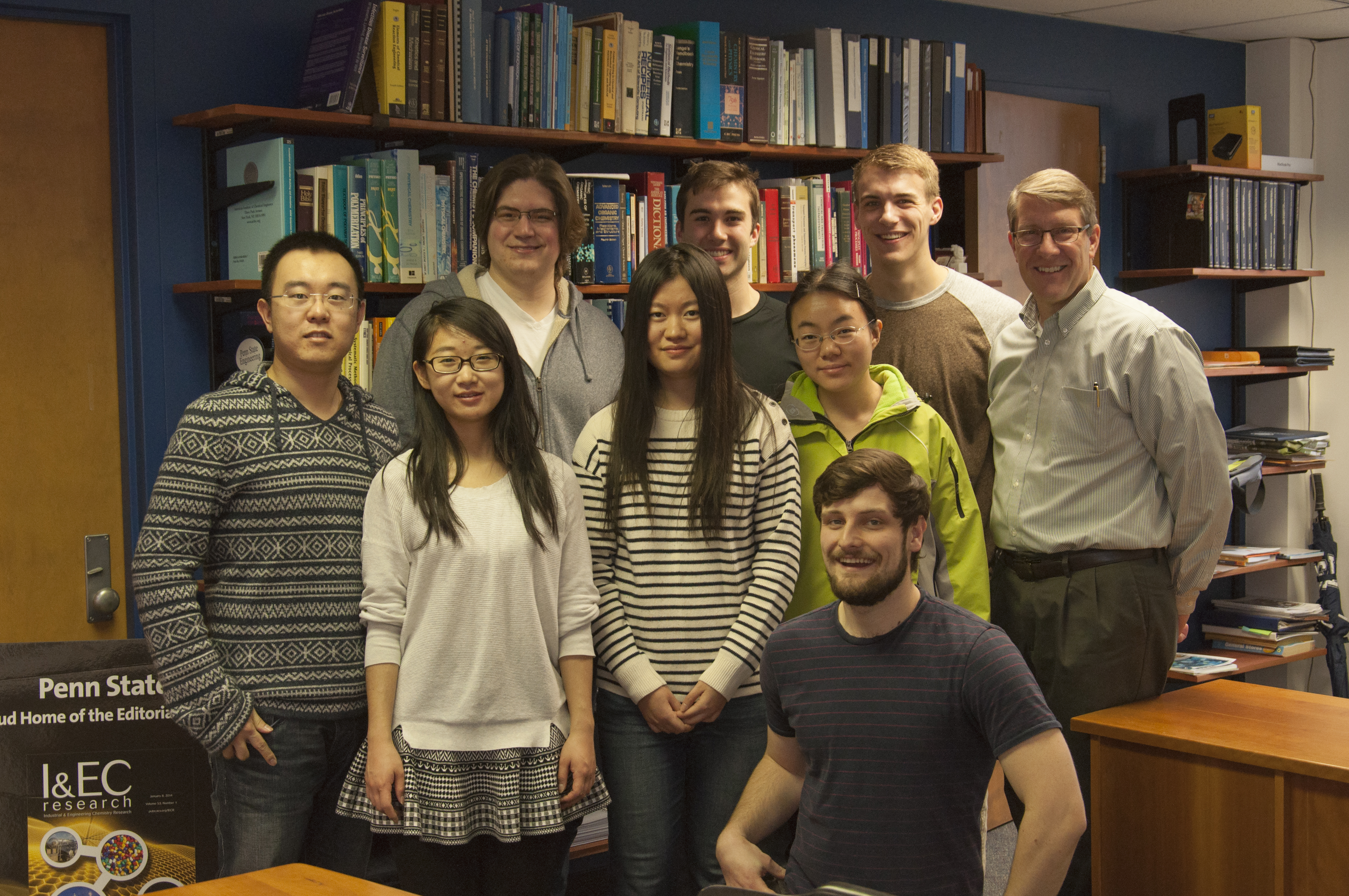
(Top row, left to right) Jonathan Harcourt, Zach Berquist, Nate Kokinski, Phil Savage
(Bottom row, left to right) Xian Wu, Xueying Zhao, Jimeng Jiang, Lili Qian, James Sheehan
We have asked the graduate students within Dr. Savage’s group questions related to their research and here are some of their responses.
So let’s start off with a small ice-breaker ChE style, what is your favorite equation of all time?
Jimeng Jiang: My favorite equation is Fenske equation because Fenske is an alumni of Penn State!
James Sheehan: One of my favorite equations is the residual sum of squares due to its simplicity and robust use in optimization.
Xueying Zhao: My favorite equation is mass balance because it is an important equation in chemical reaction and we can derive other equations from it.
Jonathan Harcourt: I don’t really have a favorite equation. However, if I was forced to chose I would say the fundamental equation of thermodynamics, because it can be used to derive all of the other equations in classical thermodynamics.
Let’s talk more about your research. I understand that Dr. Savage’s research focuses on biofuels. What is your project and what is the major problem that your project is trying to solve?
James Sheehan: My current research focuses on the hydrothermal liquefaction (HTL) of proteins. HTL is a thermochemical process that uses water at elevated temperatures (200 – 400oC) and pressures (10 MPa – 40 MPa) to transform biomass into biocrude-oil, a renewable fuel precursor. Biomass feedstocks are often rich in proteins and understanding their involvement in HTL is pertinent to producing high quality biocrude-oil. My research interests are identifying and modeling the reaction pathways involving proteins during HTL and their incorporation into biocrude-oil and recovery as valuable co-products such as amino acids or other nutrients.
Jimeng Jiang: My research project is ‘Demetallation of Biocrude from Hydrothermal Liquefaction of Microalgae’. Biofuels have the potential to be an alternative fuel of petroleum in the future. I am trying to remove the detrimental metals such as iron and sodium from algal crude oil to improve the quality of crude oil.
Xian Wu: Catalytic Fast HTL of Micro-algae. With the increasing demand for fuel, the limited amount of the fossil fuels may be a potential cause of an energy crisis. Micro-algae, which could be raised rapidly and harvested without consuming arable land, has shown its great potential to be processed into bio-crude, which is regenerable fuel. Without drying the harvested micro-algae, HTL fulfills the goal of converting the bio-feedstock into energy-condensed fuel. Recently, research proved that Fast HTL provided a higher yield of bio-crude than isothermal HTL. My project involves identifying catalysts that increase the quantity and quality of the bio-crude through Fast HTL of micro-algae and conducting kinetic analysis on the catalytic fast HTL. The final goal of the research is to formulate a realistic model that can predict the process of catalytic fast HTL of micro-algae.
Jonathan Harcourt: My research focuses on the effect of salt water on the process of HTL. One of the most promising potential biomass feedstocks is microalgae, because of its rapid growth rate. Many of the fastest growing microalgae grow best in seawater. My research is investigating whether additional salts in seawater will affect the HTL process. I will also do the same for catalytic HTL, since different components of seawater (i.e. Cl- ions) are known to poison many of the best catalysts for HTL.
Xueying Zhao: My research project is hydrothermal liquefaction of a microalga with a core-shell catalyst. The major problem that I’m trying to solve is about the deactivation of catalyst in the reaction. I’m trying to use the shell to isolate the catalytic core with algae.
Lili Qian: My research project is the hydrothermal liquefaction of sludge, aimed to produce biocrude oil using municipal sewage sludge. This research is trying to solve the sludge disposal problems, such as secondary pollutants caused by incineration and landfills. Also, waste biomass can be converted to biocrude oil to solve the energy shortage problems.
Dr. Savage’s group at Penn State is relatively young (started in 2014), but has the group been able to publish any papers? Additionally, have you attended or will you attend any conferences in the near future?
James Sheehan: This past spring, we published a journal article regarding the HTL of soy protein concentrate (Products and Kinetics for Isothermal Hydrothermal Liquefaction of Soy Protein Concentrate). This upcoming August, I will be presenting at the ACS Conference in Philadelphia, PA on HTL of proteins.
Thank you members of Dr. Savage’s group for taking the time to talk about their group.
Dr. Mou Paul (Dow Chemical) seminar on “Nanofiltration Membranes: Fundamentals & Applications”
Dr. Mou Paul, Research Scientist for DOW Water & Process Solutions, a business unit of The DOW Chemical Company, will be presenting a seminar titled:
“Nanofiltration Membranes: Fundamentals & Applications”
Thursday, June 16, 2016 at 10:00 am in 110 Wartik.
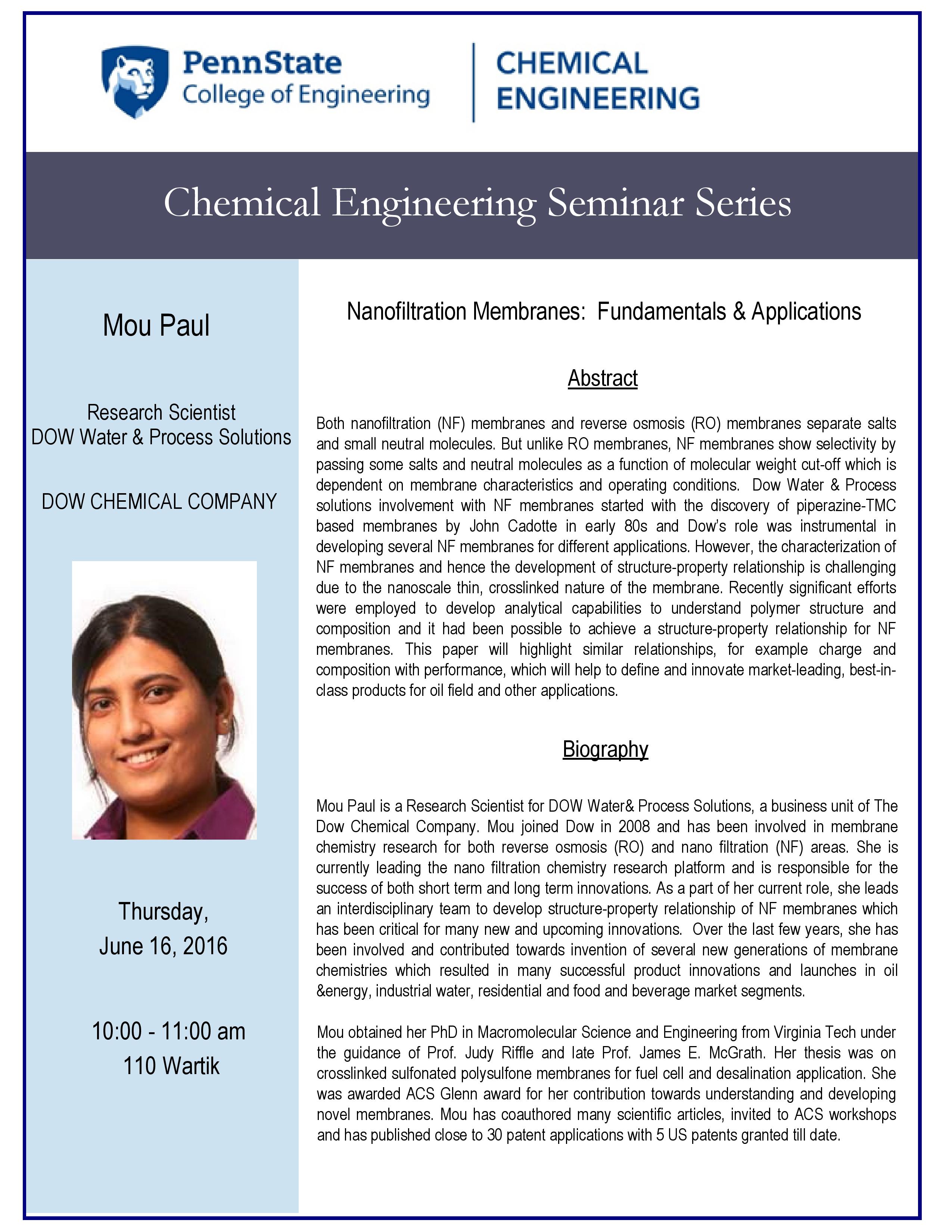
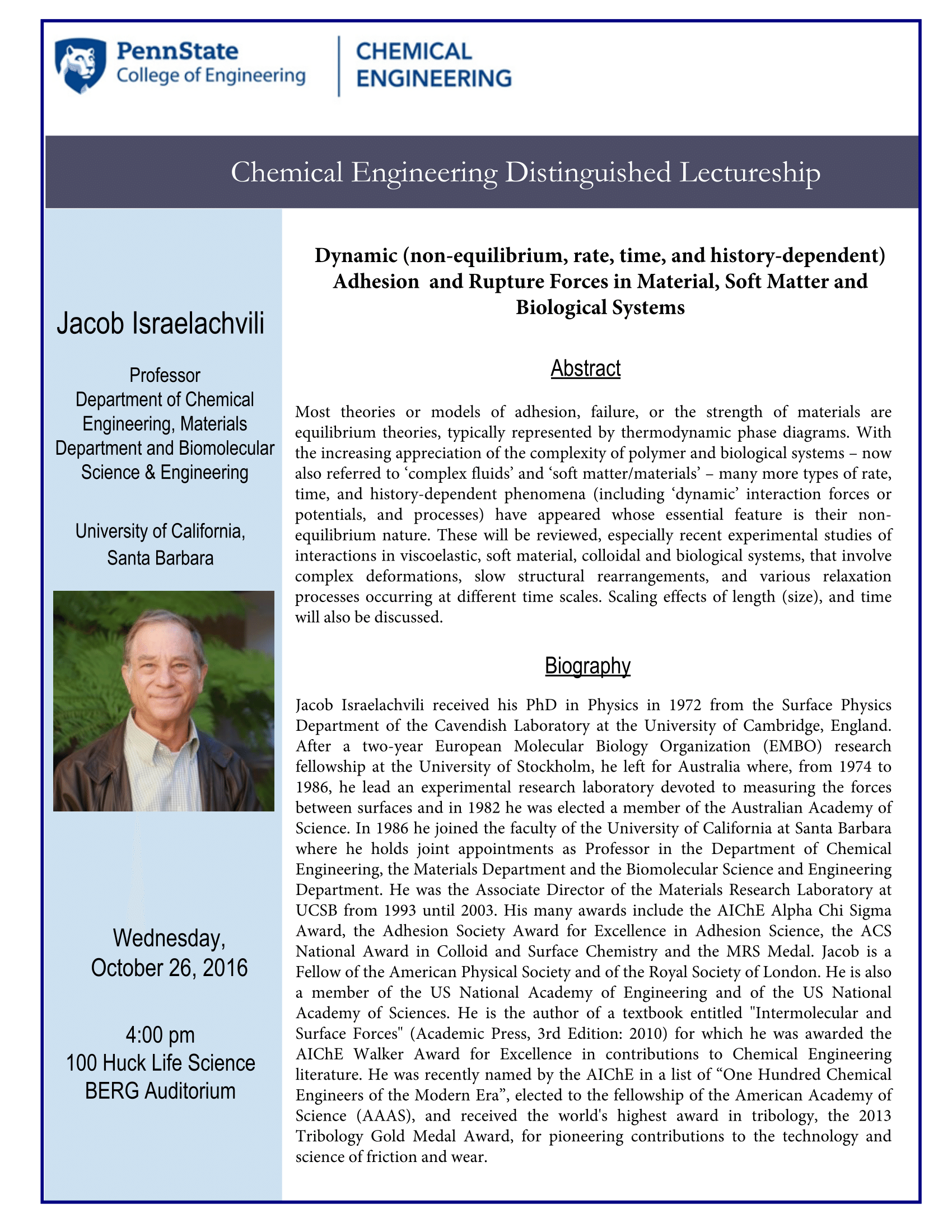
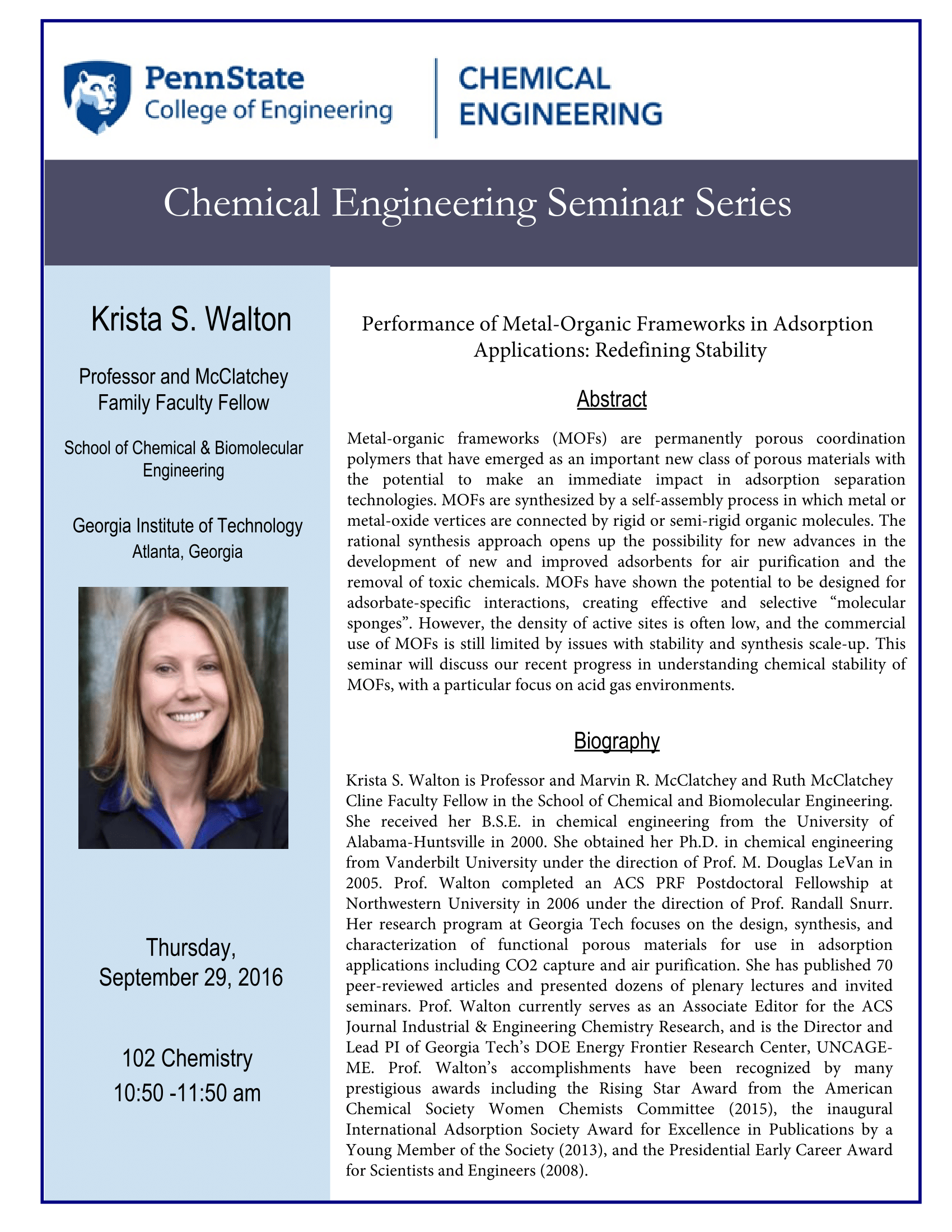





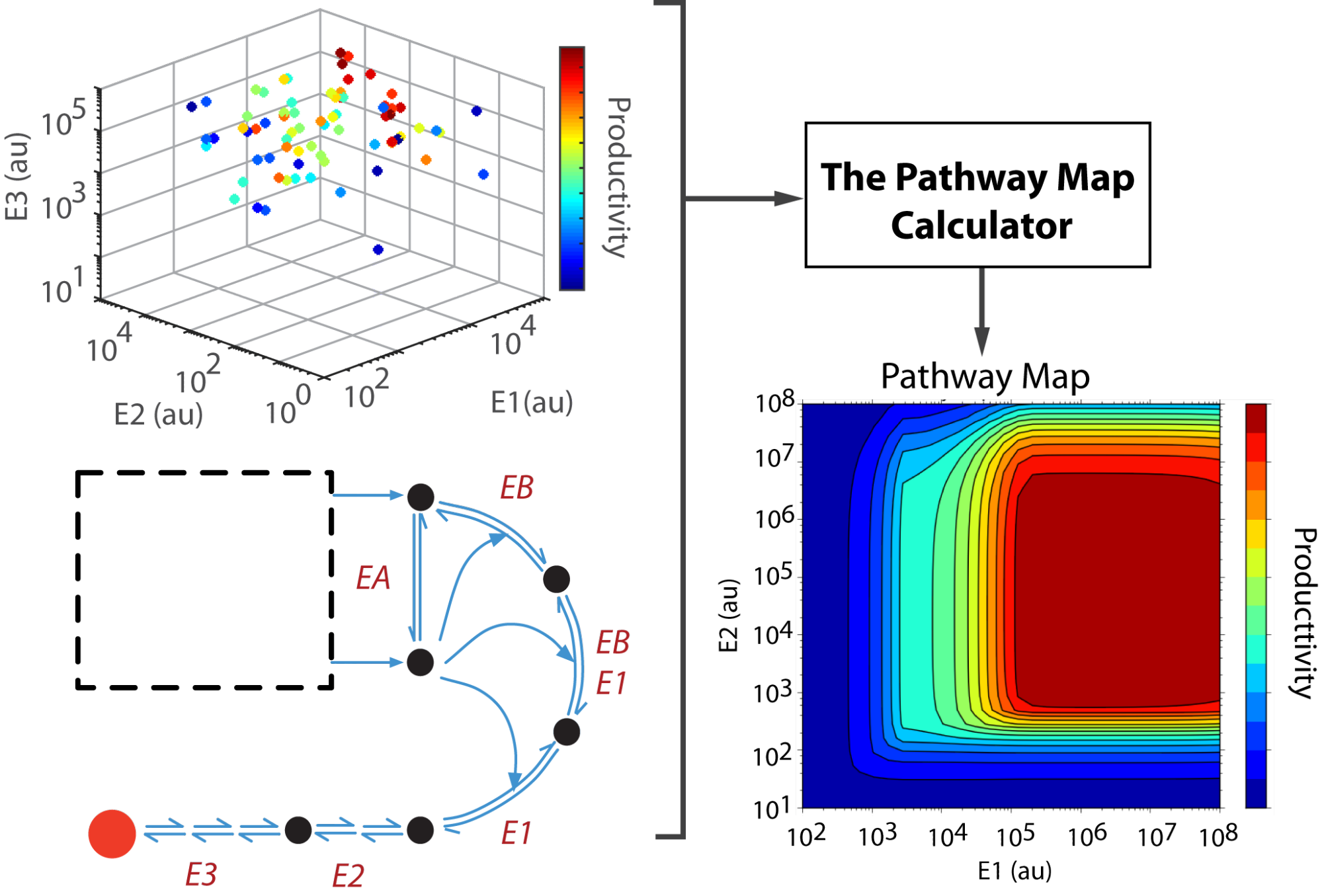

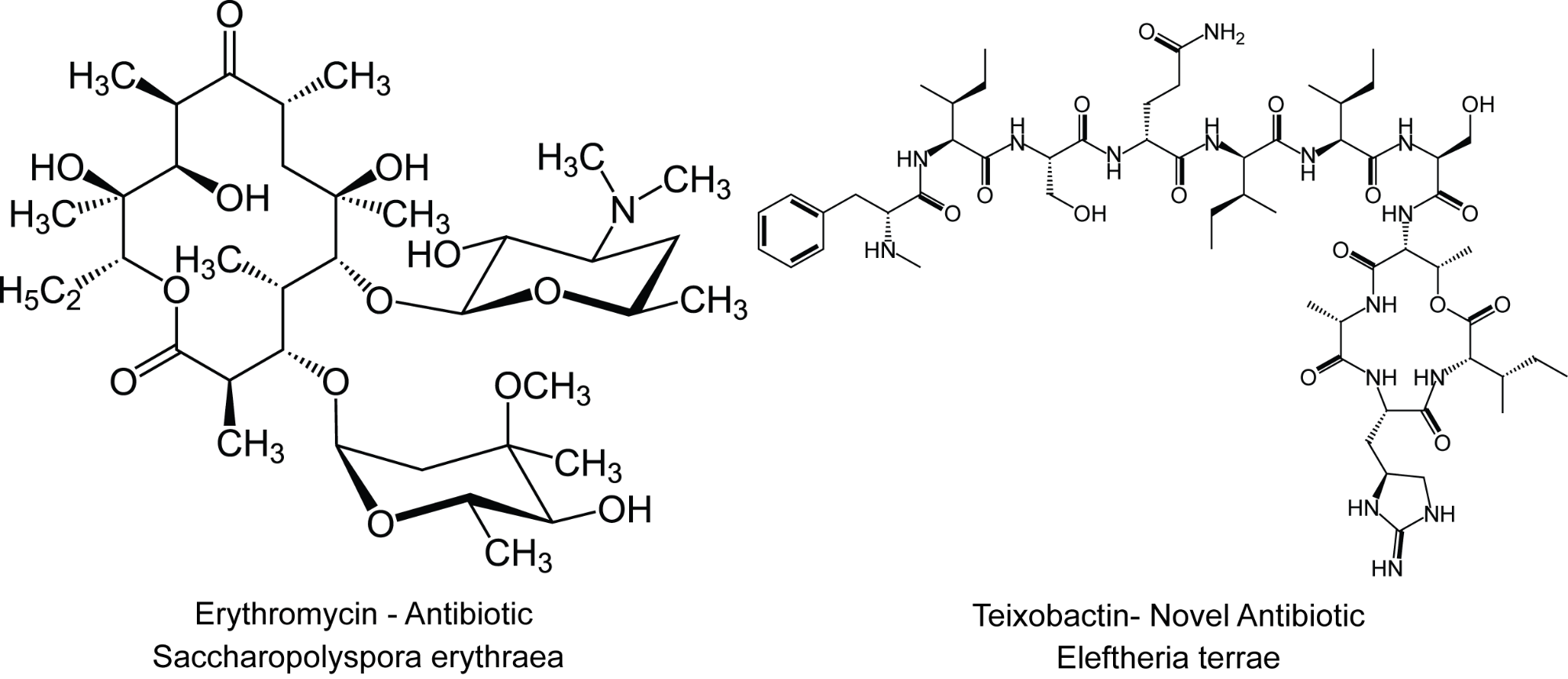

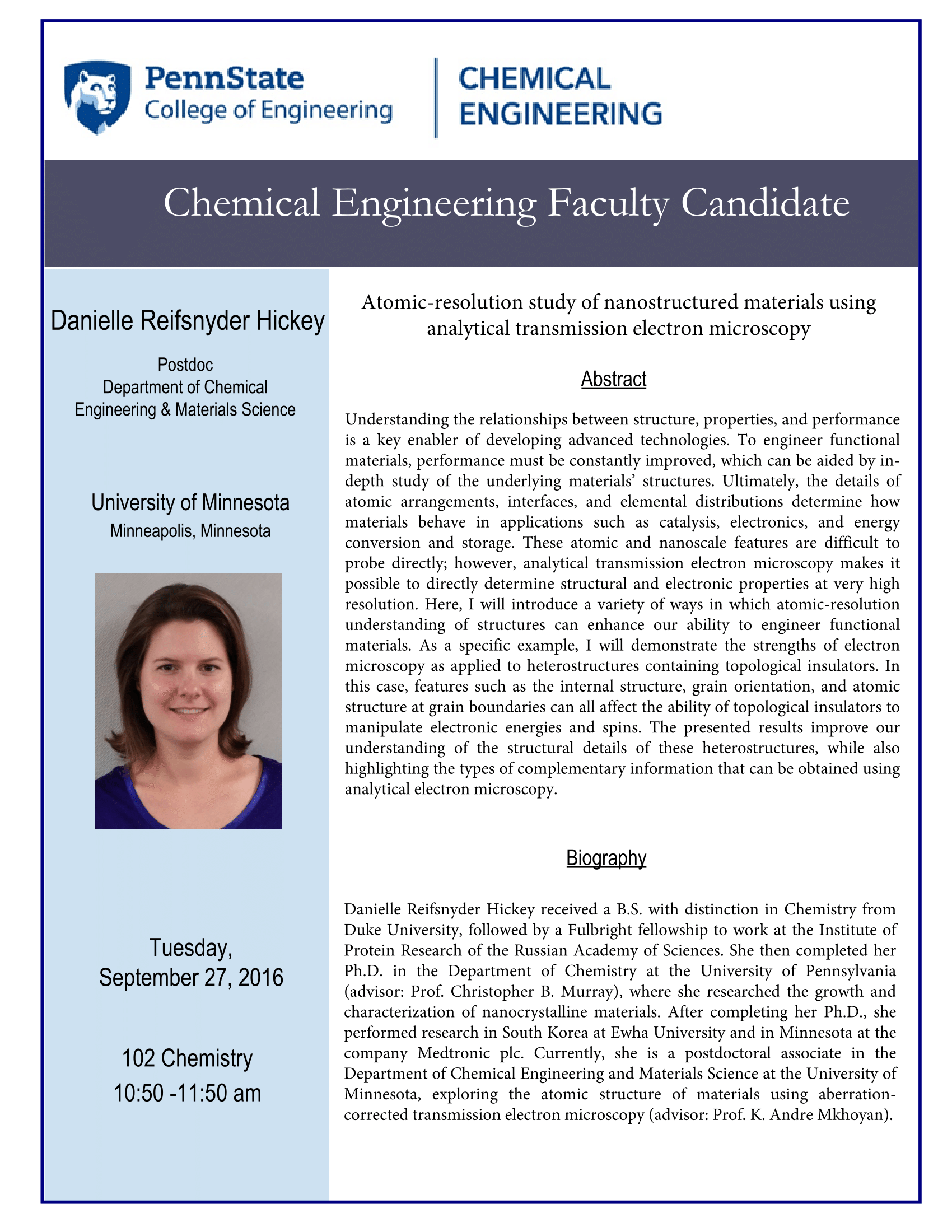

You must be logged in to post a comment.